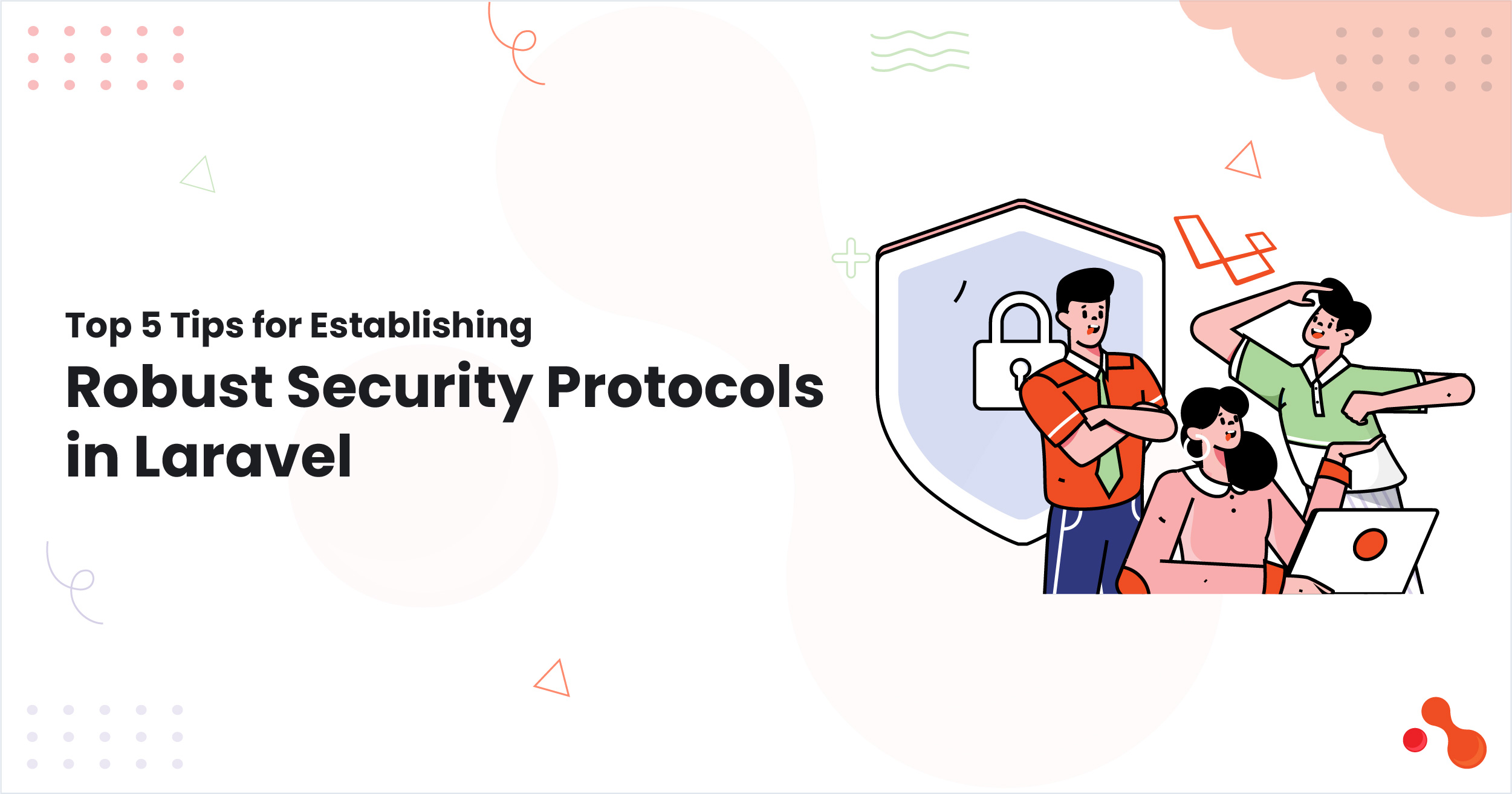Introduction
Laravel, a popular PHP framework known for its elegance and simplicity, provides a robust foundation for building secure applications through Security Protocols in Laravel. In the ever-evolving world of web development, Security Protocols in Laravel stand as a critical pillar that sustains the integrity and trustworthiness of applications.
Establishing robust Security Protocols in Laravel is crucial for protecting your application from potential threats and vulnerabilities. However, ensuring optimal security takes more than simply implementing the basic features of Laravel. It requires a proactive approach to establish and maintain comprehensive Security Protocols in Laravel for maximum protection.
Laravel, being a highly popular PHP framework, offers a variety of built-in features and practices to enhance security. Here are some essential tips to help you fortify your Laravel applications.
Essential Tips
Establishing robust security protocols in Laravel is crucial for protecting your application and its users from a wide array of cyber threats. Ensuring strong security practices is essential for safeguarding sensitive data, maintaining the integrity of your system, and building trust with your users.
Businesses should ideally make the smart decision to outsource their Laravel requirements and hire Laravel developers. This is a good way to ensure they build a secure solution.
The top 5 tips for establishing robust security protocols in Laravel are:
- Implement basic Laravel security
- Authentication and Authorization
- Laravel Security Packages
- Following Best practices
- Security Testing in Laravel
Here it is in more detail:
Implement basic Laravel security:
Implement basic security measures in Laravel to protect your application from common vulnerabilities. Laravel provides built-in tools and best practices for improving application security:
Environment Configuration Security: The .env file stores sensitive configuration data such as database credentials, API keys, and encryption keys. This file should never be exposed in version control (add .env to your .gitignore file). Setting APP_DEBUG=false in production prevents exposing detailed error messages that might give attackers valuable information about the system. Recommended settings for the production .env file:
Code
APP_DEBUG=false
APP_ENV=production
Use HTTPS (SSL/TLS):
Ensure your Laravel application is served over HTTPS in production to protect data in transit. Force HTTPS across the application by adding middleware. Apply this middleware globally to ensure the application always redirects HTTP traffic to HTTPS:
Code
// App\Http\Middleware\RedirectIfNotHttps.php
public function handle($request, Closure $next)
{
if (!$request->secure()) {
return redirect()->secure($request->getRequestUri());
}
return $next($request);
}
Cross-Site Request Forgery (CSRF) Protection:
Laravel has CSRF protection enabled by default for all POST, PUT, PATCH, and DELETE requests. Add the @csrf directive to your forms to protect against CSRF attacks. If you need to exempt specific routes from CSRF verification (though not recommended), you can define them in the VerifyCsrfToken middleware:
CODE
<form method=”POST” action=”/submit”>
@csrf
<input type=”text” name=”name”>
<button type=”submit”>Submit</button>
</form>
SQL Injection Protection:
Laravel’s query builder and Eloquent ORM automatically use parameter binding to protect against SQL injection. For example, avoid using raw queries:
CODE
// Instead of this (not secure):
DB::select(“SELECT * FROM users WHERE email = ‘$email'”);
//Use parameter binding (secure):
DB::select(“SELECT * FROM users WHERE email = ?”, [$email]);
When using Eloquent or the query builder, parameterized queries are automatically handled:
CODE
User::where(’email’, $email)->first();
Cross-Site Scripting (XSS) Protection:
Laravel automatically escapes output to prevent XSS attacks. Always use Blade templating to display variables in your views. Never trust user input and always sanitize or escape it before outputting it in views:
CODE
<!– Safe output escaping –>
{{ $user->name }}
If you need to display raw HTML (be cautious), use the {!! !!} syntax:
CODE
{!! $user->bio !!}
Rate Limiting:
Laravel provides built-in support for rate-limiting API routes to prevent brute-force attacks. You can define rate limits using the throttle middleware. This example limits a user to 60 requests per minute for the /login route:
CODE
Route::middleware([‘throttle:60,1’])->group(function () {
Route::post(‘/login’, ‘AuthController@login’);
});
Security Headers:
Add essential security headers like Content-Security-Policy, X-Frame-Options, Strict-Transport-Security, etc., using middleware. You can use the Laravel Secure Headers package to automatically add security headers to your Laravel app.
- Disable Directory Indexing: Ensure directory listing is disabled on your web server. In Apache, you can add this to your .htaccess file:
CODE
Options -Indexes
- File Upload Security: Always validate and sanitize file uploads. This ensures that uploaded files are limited to specific types and size restrictions. Store uploaded files in a safe directory and avoid executing them:
CODE
$request->validate([
‘file’ => ‘required|mimes:jpg,png,pdf|max:2048’,
]);
Logging:
Ensure proper logging of security-related events, such as failed logins or unauthorized access attempts. Laravel’s logging feature is configured in config/logging.php and can help track suspicious activity.
Sanitize User Input: Use Laravel’s built-in validation to sanitize user input:
CODE
$validated = $request->validate([
‘name’ => ‘required|string|max:255′,
’email’ => ‘required|email’,
]);
- Error and Exception Handling: Configure Laravel’s error handling to log errors without displaying sensitive configuration values to the end user. Implement a comprehensive logging strategy that includes file logging, email notifications, and even SMS alerts for critical issues.
- Keep Laravel and Packages Up-to-Date: Install security patches when they become available. They include security patches that fix vulnerabilities discovered since the last version. The updates can also introduce new security features and improvements that enhance the overall security posture of your application. Use composer update regularly to update Laravel and its dependencies. Subscribe to Laravel and security community newsletters to stay informed about critical updates.
- Secure Data Handling: Use Laravel’s powerful validation rules to ensure all incoming data is of expected form and content. Sanitize inputs to prevent SQL injection and cross-site scripting (XSS) attacks. Encrypt sensitive data in your database using Laravel’s built-in encryption facilities. Use HTTPS to encrypt data transmitted between the client and server, configuring SSL/TLS on your web server.
Authentication and Authorization:
It uses built-in authentication and authorization features to ensure that only authorized users can access certain parts of your application. It also introduces enhanced security features, building on its already strong foundation to ensure developers can build highly secure applications.
- Authentication: Use Laravel’s Auth system to handle user authentication. Utilize Laravel’s built-in features, such as Laravel Breeze, Jetstream, or Fortify, to manage authentication securely. Implement two-factor authentication (2FA) to add an extra layer of security.
- Authorization: You can use gates and policies for role-based or resource-based authorization. They handle the authorization logic. It requires the user roles and permissions to be clearly defined and enforced at both server-side and client-side levels.
- Built-In Encryption: Laravel 11 offers powerful encryption using the AES-256 and AES-128 algorithms. This ensures that sensitive data like passwords, tokens, and user information are securely encrypted both in storage and during transmission.
- Automatic Password Hashing: Laravel 11 continues to provide strong password hashing using the bcrypt and argon2 algorithms. This prevents passwords from being stored in plain text and offers protection against brute-force attacks.
- Two-Factor Authentication (2FA): With the growing need for enhanced security, Laravel 11 supports two-factor authentication (2FA) for user logins, adding an extra layer of security beyond the standard username and password.
Laravel Security Packages:
Laravel packages offer various features, including enhanced security. Regular updates provide security patches, new features, and improvements. Run composer update regularly to update Laravel and its dependencies, keeping security packages up to date. Below are top security packages for Laravel:
- Laravel Security: Enhances password hashing, key derivation, encryption, and signature features.
- Security Headers: Adds security-related HTTP headers to protect against attacks such as XSS.
- Laravel ACL (Access Control List): Simplifies the implementation of role-based access control (RBAC) and permissions in your Laravel app.
- Laravel Passport: Provides OAuth2 server implementation for API authentication.
- Laravel Sanctum: Provides a lightweight solution for token-based API authentication and SPA (Single Page Application) authentication.
- Laravel Shield: A security package that provides rate-limiting features, IP whitelisting, and more to protect Laravel applications.
- Laravel Honeypot: Adds a honeypot field to your forms to detect and block bots and spam submissions.
- Laravel Firewall: Provides a firewall layer for filtering requests based on IP address, allowing you to block malicious traffic.
- Laravel CipherSweet: Provides searchable encryption for sensitive data in Laravel applications.
- Laravel Recaptcha: Integrates Google’s reCAPTCHA into your Laravel forms to prevent spam and bots.
- Security Checker: Scans your composer dependencies for known vulnerabilities and provides warnings if any are found.
- Spatie Laravel Permissions: Allows easy handling of user roles and permissions within Laravel applications.
- Laravel Trusted Proxy: Manages trusted proxies in Laravel, ensuring correct handling of requests behind proxies or load balancers.
- Laravel Audit: Tracks user activities and stores an audit log of changes made to your models, adding transparency and accountability.
- Laravel Security Component: This package is useful in securing roles and objects. It does so by integrating the Symfony security core into Laravel. It helps verify the role-based privileges, enhancing security validations using voters.
Best practices:
It is vital to keep in mind that security is an ongoing process. Follow these security best practices to enhance the security of your Laravel applications:
- Limit access to sensitive data: Limit access to sensitive data, such as credit card numbers or passwords, to only those who need it. Use Laravel’s built-in encryption features to protect sensitive data.
- Use a Web Application Firewall (WAF): Use a WAF, such as Laravel’s built-in WAF or a third-party WAF, to protect your application from common web attacks.
- Implement a secure development lifecycle: Implement a secure development lifecycle to ensure security is integrated into every stage of the development process. Use security testing and code reviews to identify security issues early in the development process.
- Prevent SQL injection by avoiding raw queries: It is not uncommon for developers to use raw queries, which tends to leave the code vulnerable to attacks. The main reason Laravel has provided a framework for this purpose is because it uses PDO binding to prevent SQL injection attacks. It does not allow variables to be passed to the database without validation. Raw query issues are prevented by the experts with high-level coding. However, it is not advisable to use raw queries.
- Monitor for Vulnerabilities: New security vulnerabilities are constantly being discovered. Regularly scan your dependencies using tools like Laravel Security Checker or Snyk to detect vulnerabilities:
CODE
composer requires enlighten/security-checker –dev
php artisan security:check
Security Testing in Laravel:
Automated security testing in Laravel is an essential practice for ensuring that your web application is secure from vulnerabilities throughout the development lifecycle. Laravel, being a PHP framework, has its own security features, but combining these with automated testing tools ensures that security is continuously enforced as the application evolves. Here’s how automated security testing can be implemente in Laravel:
Integration of Static Application Security Testing (SAST)
- Tools: Tools like SonarQube, PHPStan, Psalm, or RIPS can perform static analysis on your Laravel codebase. These tools help catch vulnerabilities like SQL injection, cross-site scripting (XSS), insecure data storage, and more.
- Automation: Integrate these tools into your CI/CD pipeline to automatically scan code after every commit. This ensures developers are notified of potential security issues early in the development process.
Dynamic Application Security Testing (DAST)
- Tools: Tools like OWASP ZAP or Burp Suite are used to run automated tests on running Laravel applications. They look for vulnerabilities by interacting with the app’s endpoints and attempting common attacks (e.g., XSS, SQL injection).
- Automation: These tools can be configured to run during automated testing in the CI/CD pipeline. They test the application from an attacker’s perspective, catching vulnerabilities in real-world scenarios.
Dependency Scanning
- Tools: Laravel applications often use third-party packages through Composer. Tools like Snyk, Dependenbot, or PHP Security Advisories scan your Composer dependencies for known security vulnerabilities.
- Automation: Use these tools to automatically scan and notify the team of insecure or outdated packages. This can be integrate into the pipeline to prevent deploying vulnerable libraries.
Unit and Integration Testing for Security
- Laravel’s testing capabilities (using PHPUnit) allow you to write unit tests and integration tests that can focus on security-critical parts of the application:
- SQL Injection: Test database queries for SQL injection vulnerabilities by ensuring proper Use of Laravel’s query builder and Eloquent ORM.
- Cross-Site Request Forgery (CSRF): Laravel includes CSRF protection by default, but testing can ensure that these protections work correctly across your application.
Authentication and Authorization: Test your authentication mechanisms (login, registration) and authorization policies to ensure they work securely.
- Input Validation: Ensure input validation rules are apply correctly to prevent attacks like file uploads or malicious input.
Custom Security Middleware Testing: Laravel allows you to create custom middleware to handle security concerns (e.g., rate-limiting, IP blocking, additional encryption). Automated tests can validate that the middleware works as intended and provides the desired protection.
Test Examples:
- Ensure API endpoints are correctly rate-limited.
- Validate that middleware for enforcing HTTPS or input sanitation is apply correctly. Continuous Integration/Continuous Deployment (CI/CD) Pipeline
- Integrate security testing into your CI/CD pipeline to automatically test for vulnerabilities in every commit, build, or deployment.
Tools: Jenkins, GitHub Actions, GitLab CI, and CircleCI can be use to orchestrate security tests like SAST, DAST, and dependency scanning as part of your deployment process. You can configure automated alerts to flag security issues early in development.
Automated Security Testing for APIs
- API Vulnerabilities: APIs are often vulnerable to attacks like rate-limiting bypass, broken authentication, and sensitive data exposure. Automated API security testing tools such as Postman or Insomnia combine with security test suites can be use to test API endpoints.
- Laravel Passport/Sanctum: If you’re using Laravel Passport or Sanctum for API authentication, ensure you write tests that validate proper Use of OAuth tokens or personal access tokens.
Configuration and Environment Security Testing:
Laravel’s configuration files (.env, config/) are critical for securing the application. Automated tests can ensure:
- Sensitive Data: No sensitive data like API keys or passwords are hard-coded or exposed.
- Debugging Mode: The application does not have debugging mode enabled in production environments (APP_DEBUG=false).
- Encryption: Proper encryption configurations are applied (e.g., for user passwords, sessions, and sensitive data).
Database Security Testing
- Testing Queries: Validate that all database queries are properly parameterized to prevent SQL injection.
- Data Encryption: Ensure that sensitive data is encrypted at rest (e.g., user passwords with bcrypt or argon2 hashing algorithms).
Test for Common Laravel Security Risks:
Test the application for specific security best practices:
- CSRF Protection: Laravel’s default CSRF protection must be tested, especially in form submissions.
- SQL Injection: Use automated testing to ensure Eloquent and Query Builder are used safely without risking SQL injections.
- Session Hijacking: Automated tests can check whether secure sessions are implemented using HTTPS and cookies are flagged with the Secure and HttpOnly attributes.
Security headers validation: Whether the correct HTTP security headers (e.g., Content-Security-Policy, X-Content-Type-Options, Strict-Transport-Security) are implemente can be valid by automated security tools. Tools like securityheaders or Laravel Security Headers package can help enforce these headers.
Laravel Development Services From Acquaint Softtech
Business can benefit from turning to the professionals when it comes to developing a secure application. They have the expertise and experience to develop cutting-edge solutions.
Laravel Partners are firms with specialised skill and resources to develop next-generation solutions. They also have knowledge on how to develop secure solutions. Opting to hire such a Laravel development company can help businesses gain the upper edge.
Looking for secure Laravel development? Acquaint Softtech has you covered! The expert team at Acquaint Softtech will ensure your Laravel application is protecte with top-notch security protocols to guard against threats and vulnerabilities. From data encryption to secure authentication, we take every step to keep your app safe.
Acquaint Softtech is a Laravel partner, one of the few in Asia. We are a well-established software development outsourcing company in India with over 10 years of experience. In fact, we have already delivered over 5000 projects successfully worldwide.
Hire remote developers from here for highly secure applications. Our team of dedicated Laravel developers have both the experience and skill to build flawless solutions. Besides which we also have a dedicated QA team to build a state-of-the-art solution.
Conclusion
Security in Laravel, including Security Protocols in Laravel, is not just a feature but a continuous practice that should be integrate into every stage of application development and maintenance. By adhering to these tips and continually updating your knowledge and practices in response to emerging threats, you can significantly enhance the security of your Laravel applications.
Remember, effective security is about layers; implementing multiple security measures and Security Protocols in Laravel enhances the overall security of your application, making it harder for attackers to breach.


